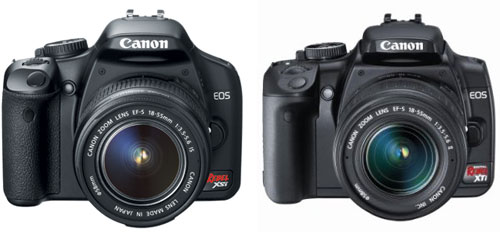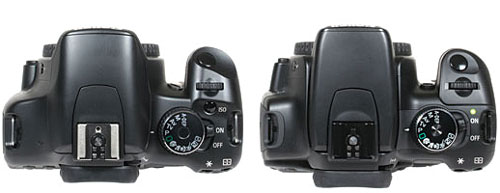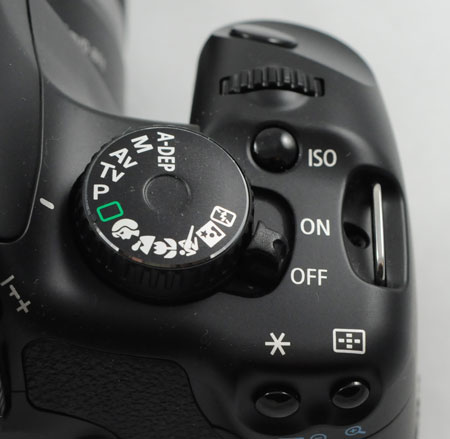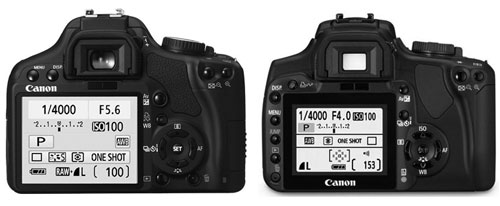Canon XSi: 12.2 Megapixels, Image Stabilized Lens, and Double Live View
by Wesley Fink on May 5, 2008 3:00 AM EST- Posted in
- Digital Camera
XSi compared to XTi
As the top-selling model in the DSLR universe, each new Canon builds on the previous model's footprint and features. This evolutionary approach keeps new Rebels familiar, but Canon also has managed to keep their entry flagship fresh with the latest must-have features and new Canon innovations.

The XSi is more rounded and less angular than the XTi. It is also slightly larger than the XTi to accommodate the larger 3" LCD.
| Canon XSi vs. Canon XTi | ||
| XSi | XTi | |
| Dimensions | 129 x 97.5 x 61.9mm 5.1 x 3.8 x 2.4" |
126.5 x 94.2 x 65mm 5.0 x 3.7 x 2.6" |
| Weight | 475g (16.8oz) - Body only 525g (18.5oz) - with Battery |
510g (18oz) - Body Only 556g (19.6oz) |
The XSi is 2.5mm wider and 3.3mm taller than the XTi. However, it is 3.1mm less deep and 35g lighter than the current XTi. The overall impression is the XSi is slightly larger than the XTi, and it is surprisingly light. The rubber grip cover is now more "texturized" with subtle changes to the shutter release depression and angle. The grip is more comfortable to hold for larger hands (still improved by adding the grip), but it is a good fit for smaller hands.
Build quality seems a cut above earlier Rebels and the appearance is definitely classier and more in keeping with the rest of the Canon DSLR line. The XSi has been described as looking like a mini 40D and that is an apt description. The XSi is also the most rugged Digital Rebel ever built with a stainless-steel chassis and a glass-reinforced engineering plastics body.

The XTi ON LED is gone, something that may matter to some users. If you look closely you can see that the shallower XSi is entirely due to the stubbier pentamirror/flash housing, which does not overhang as much as in the XTi.

The XSi adds an ISO button just above the on-off switch. ISO is also now displayed in the viewfinder (finally!).

The biggest changes in the XSi are on the back where the new 3" LCD looks absolutely massive compared to the XTi's 2.5" screen. The 3" screen is the same size and specifications as the Canon 40D screen. It is also the largest screen in its class - the Nikon D60 and Olympus 510/420 are 2.5", while the Sony A350/300/200 and Pentax K200D are 2.7".
The larger screen on the XSi required a complete rearrangement of rear buttons as well. There are no longer buttons on the left and the Menu and Display buttons are now at the top left of the screen.
The right side control buttons and layout are basically the same as the XTi, with the addition of the playback and delete (trash) buttons at the bottom right of the screen. The drive/timer button has been reassigned to a directional pad button and the old button is now assigned to White Balance. In a quick glance at the XSi rear you would think it has been simplified, as it looks as if there are fewer buttons. However, all the buttons and functions are still there; they are just rearranged.

The XSi is the first Canon camera to use SD cards, a break with all previous Digital Rebels that used Compact Flash cards. This is really not a handicap at all since SD cards are now priced about the same as Compact Flash. The latest Class 6 SDHC cards are also very fast, just like the high-speed CF cards. All test shots with the XSi used a 16GB Class 6 SDHC card for image storage. The operation was trouble free and very fast.

XSi introduces a new battery that is incompatible with past models. The electrical contacts are contained in the bump on the battery - presumably to prevent accidental contact and discharge in the camera bag. The new LP-E5 (50g) rechargeable battery weighs about the same as the NB-2LH (46g) which powered the XT and XTi models. However, battery output increases about 50% to 1080 mAh compared to the 720 mAh of the NB-2LH. Battery life was not an issue with the XTi as Canon CMOS sensors are justly famous for low power consumption. The XSi battery life is even better, with plenty of reserve for driving the 3" LCD and Live View.

With the new LP-E5 battery also comes a new battery grip called the BP-E5. Then new BP-E5 works only on the XSi; it is incompatible with the earlier Digital Rebel grip. The earlier BP-E3 will not work on the XSi.
The new BP-E5 requires the battery cover be removed for mounting. The grip has a place to store the battery cover on the grip so it is not lost. Power for the grip is either one or two LP-E5 batteries. The grip also comes with an AA battery holder for six AA-size batteries as an alternate power source. We tested the grip with high-capacity rechargeable AA batteries and they worked fine as a power source.
It is definitely worth mentioning that the grip with two BP-E5 batteries is still extremely light, but the two dedicated batteries pack a wallop with 2160 mAh available. Unlike the Sony proprietary batteries, the new LP-E5 batteries are already available OEM from third party vendors.
An added feature of the BP-E5 is that it does provide some weather sealing, unlike the previous Digital Rebel grip. While Canon does not make a big deal of the feature, the XSi does provide some weather sealing, which is more a prosumer model feature.










56 Comments
View All Comments
punchkin - Thursday, May 8, 2008 - link
So the upshot of it is that it is not PRESUMABLY rated at 50,000. You don't know, and pulled a number out of your butt.mikett - Wednesday, May 7, 2008 - link
Can anyone indicate the relative lifespan rating on the XSi vs the 40D?I once recalled that the 40D class ( 20D, 30D ) had a significantly higher rating than the Rebel class and their construction was sturdier but maybe that has changed.
mmusterd - Tuesday, May 6, 2008 - link
In fact in many ways the XSi is a much more exciting new camera than the 40D was when it was introduced just 6 months ago.Well, yes. It means the 40D is dropping in price, and op top of that, here in Europe, Canon is giving a substantial cashback om the 40D (of 150 euros). This means that the price difference between the 40D and 450D has practically vanished (at a randomly picked shop the 40D body now comes at 750 euros, whereas the same shop charges 660 euros for a 450d body).
This means that at about the same price (or at least a small premium) you can get the 40D instead of the 450D. Now tell me the reasons why I should buy the 450D instead.
For myself, I couldn't think of any, so I bought the 40D. For the article, in light of the very small current price difference, perhaps more thought could be given to the comparison between the two canons.
Wesley Fink - Tuesday, May 6, 2008 - link
You make a very good point. At the same price I would also select the 40D, but that is likely an anomaly due to the fact that the XSi was just introduced and its price is staying stubbornly at a higher price, while the 40D is now more than 6 months old. That pricing is certainly because resellers are having no problem selling the XSi at the higher price.We fully expect prices to settle down to a 20% to 40% price premium for the 40D. At that price difference it is easier to justify the XSi instead.
I do believe the size and weight of the XSi will appeal more to some users. Even with the grip the XSi is smaller and much easier to carry around all day than a 40D. Ergonomics are also the best so far from an entry Canon.
n4bby - Wednesday, May 7, 2008 - link
even with the improved ergonomics of the rebel, there is a huge advantage of the 40D: the scroll wheel control on the back. Canon uses this control on all their pro models as well and i cannot overstate what a huge usability difference this makes when you're shooting... i have the old 10D, and when i tried using a friend's rebel i was constantly frustrated by the tiny little cursor button controls on the back... when you're trying to quickly adjust your exposure on the fly it's hopelessly clumsy compared to the wheel. i seriously would pay $$ for that advantage alone.PokerGuy - Tuesday, May 6, 2008 - link
Wes, good work on this article. Most AT readers including myself are technically oriented and interested in all sorts of technology. We use cameras like the ones you review but we are not photography pros. Your kind of review is exactly what I like to see, not the ones done at the photo-pro kind of sites, those have a different target audience.Keep up the good work.
punchkin - Tuesday, May 6, 2008 - link
... and I don't mean it's aimed at third graders, either.kiii - Monday, May 5, 2008 - link
Thanks for another camera article Wesley, they are getting better and better.One thing that you have already touched on, but might want to investigate further are the noise reduction algorithms that different manufacturers use. For out of camera jpegs, Nikon tends to eliminate chrominance noise, while Canon leaves small amounts of chrominance noise. The result are small colored specs on high ISO Canon jpegs, while Nikon jpegs look more like "film grain". On the other hand, Sony seems to implement very aggressive (for DSLRs anyway) noise reduction in the a350, leading to the jagged edges you mentioned. Since this is AnandTech, there are definitely power users here and these users may want to shoot in raw. Perhaps for future DSLR reviews, you can do a raw comparison, using the same raw converter for all cameras. This way, you can bypass the camera's noise reduction and see the sensor's true performance. I know that the majority of first time DSLR users will not shoot in raw, but then again, not everyone overclocks their system either.
Either way, I did get a chance to play with the XSi myself, and it is quite the camera. I look forward to your XSi comparisons with the K20D and D300.
cray85 - Monday, May 5, 2008 - link
Your article mentions that the Sony A350 is better then the XSi at higher ISOs. However, your sample image is "too simple". A more challenging image (especially one with more in-focus low-contrast details) would clearly show the excessiveness of the noise-reduction routines employed by the A350. You'd then be able to see some significant smudging of the aforementioned low-contrast details and also some more of the jagged artifacts you mentioned.By contrast, the Canon and Nikon cameras employ a much more conservative approach. Noise is less of a problem at smaller print sizes but the detail loss due to heavy-handed noise reduction is an issue at all print sizes.
Also, while it's not a bad idea to compare the white balance accuracy of different cameras, sensitivity tests should always be performed with manually set white balance so that noise comparisons are consistent.
Finally, it's a good thing you've begun to stop your test lenses down to F4. However, an even better idea would be to use F8 to further increase the lens resolution and also to bring more details into focus.
I do understand the need for you to keep things simple for readers. However, this does not imply that cutting corners on crucial tests is acceptable. A beginner might decide to buy a Sony for reasons other then JPEG image quality. However, your testing should make clear the trade-offs he will have to make.
Wesley Fink - Monday, May 5, 2008 - link
I did NOT say the A350 was better at high ISO than the XSi. I said the A350 held up better than expected in comparison to the XSi. The A350 noise reduction was set to low in our image tests, and while the A350 is not superior, neither is it trounced by the Canon XSi or Nikon D60.At F8 and low ISO in our low-light tungsten setting the shutter speeds would be so low that we would create a new noise issue with long exposures. If we increased light to make F8 work better for the test range we would no longer be testing a typical interior lighting situation with high potential noise. We are not trying to determine noise in a studio lighting environment which would be a next to useless test for a typical XSi user.
F4 is a reasonable compromise that gets the f1.4 lenses in their best performance range without creating a new set of concerns that would skew the tests. Aperture is at F4 in all test shots.
I don't know too many amateurs who set manual white balance before shooting indoor available light. Most just leave it on Auto WB, but we know most of the DSLRs do a pretty poor job on Auto WB in Tungsten lighting. Our concession to that reality is to set the WB to Tungsten.
The user might know enough to set the WB to Tungsten for inside lamps and frankly the Canon is pretty awful in color balance even when we went to the trouble to set Tungsten WB. Nikon and Sony get it right under these conditions so we have to ask why Canon Tungsten WB is so biased to warm red. I think the poor Canon color in indoor Tungsten lighting is important info to provide to readers.